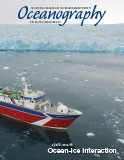Article Abstract
Calving of glacial ice into the ocean from the Greenland Ice Sheet is an important component of global sea level rise. The calving process itself is relatively poorly observed, understood, and modeled; as such, it represents a bottleneck in improving future global sea level estimates in climate models. We organized a pilot project to observe the calving process at Helheim Glacier in East Greenland in an effort to better understand it. During an intensive one-week survey, we deployed a suite of instrumentation including a terrestrial radar interferometer, GPS receivers, seismometers, tsunameters, and an automated weather station. This effort captured a calving process and measured various glaciological, oceanographic, and atmospheric parameters before, during, and after the event. One outcome of our observations is evidence that the calving process actually consists of a number of discrete events, spread out over time, in this instance over at least two days. This time span has implications for models of the process. Realistic projections of future global sea level will depend on accurate parametrization of calving, which will require more sustained observations.

